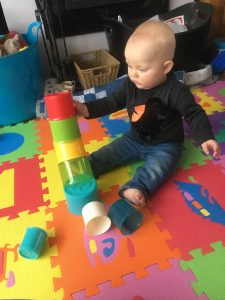Attention and listening is the basis of all communication development. If you can’t focus on someone else you will never notice their facial expressions or hear their intonation patterns or even watch how their mouth moves to make different sounds.
As Speech and Language Therapists we talk a lot about attention and listening but what are they and what do we mean?

Attention: This is the ability to focus on another person or item for a specific period of time and to be able to transfer their focus from one thing to another – e.g. from a book/toy to another person.
Listening: This is the ability to focus on auditory input (speech, music, any sound) and make sense of it.
Law & Elias, 1969 say that “Listening is one of the most important of all the skills that children need if they are to learn from their environment (the world around them)”
Children learn through watching around them and through attempting to copy what they are seeing. By developing good attention and listening skills children can then learn to:
- Develop early social interactions skills
- Understand words and follow instructions
- Develop vocabulary skills
- Develop grammar skills e.g. –ed for past tense, -s for plural
- Develop accurate speech sounds, phonic awareness and literacy
- Participate in conversations, class discussions and make friends
- Develop the ability to copy and then learn from their environment through observations.
How can we support a child’s attention and listening skills?
- If playing games ensure that it is in a quiet distraction free environment – as much as is possible in the home – tidy away toys that aren’t being played with, turn off the TV, put away phones.
- Say their name before giving any instructions to ensure that they are focussed on you and aware they need to listen.
- Start with games that have a clear start and finish so that they know what is expected of them
- Play games that grab their attention and use your intonation to make the activity exciting and grab their attention
- When reading stories use different voices for the characters and ensure you use intonation to portray emotions and build anticipation.
- Slow down your speech when giving instructions and pause, allowing the child to take in what is being said – but not too long so as to lose their focus! It’s a difficult balance but one you will find the balance that works for you and your child.
- Repetition – at a young age repetition supports a child’s attention and listening skills as it gives a level of predictability, as children get older they still like repetition but have a variety of activities so that they don’t get bored.
Games to play that support attention and listening skills:
- Copying games/ Simon Says
- Ready, steady, go games – give physical instruction following by word go have to wait till you say go – pause and wait before saying go for a bit
- Tower building – also works on turn taking skills

Stacking cups is a great activity to develop attention and cause and effect - Colouring activities where give instructions to each other
- Draw a child’s attention to everyday sounds in the home and street like the doorbell or water running, let them see and touch the sound-maker and make the sound themselves
- Help your child associate a sound with an activity, e.g. a ring a bell for meal time or the end of garden play. Lots of nurseries have songs/instruments that signal different times of the day, e.g. a tidy up song.
- While walking in the park talk to your child about the noises you hear, make noises with them, bang a stick on a fence, splash in puddles, crunch leaves.
- At bath time talk about the different sounds: splash water, swish bubbles, dribble from a sponge, plink-plonk bath toys and play with windup toys.
- Show your child different ways that sounds can be made from one sound maker; a tambourine can be shaken, tapped, scratched, hit hard or softly.
- Show your child how to make different sounds from shaking objects like keys, a rattle, a tin of rice, or bricks in a box. Talk about how they sound different.
- Make different sounds with your child using your voice; humming, whispering, laughing, singing, talking. Copy each other’s noises. (you may find yourself doing this naturally with young babies)
- Play ‘what’s in the box?’ and put in items that make different noises so you can both guess as you shake it.
Hope you find these ideas useful.